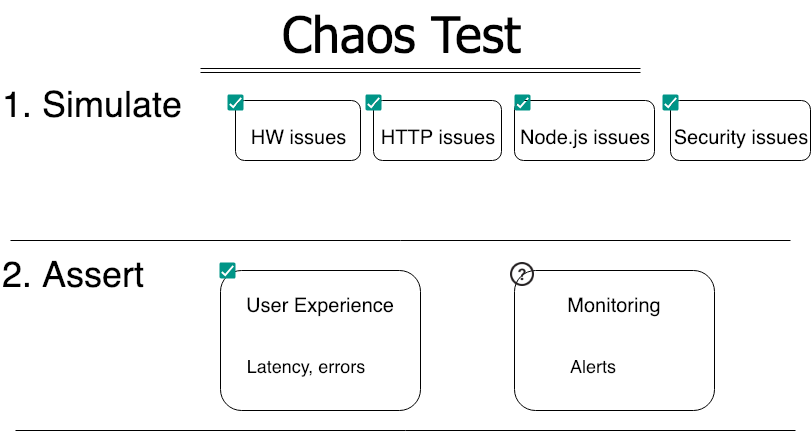Caution: Alpha mode, we're now stabilizing the functionality and enhancing the docs. Consider contributing or visiting again soon
"A software QA engineer walks into a bar
He orders a beer. Orders 0 beers. Orders 99999999999 beers. Orders a lizard. Orders -1 beers. Orders a ueicbksjdhd.
First real customer walks in and asks where the bathroom is. The bar bursts into flames, killing everyone."
Credit @brenankeller
Functional bugs are just a subset of the bad things that happen in production. In reality, unplanned chaos will affect your application reliability. How? your process will crash, the event loop might get blocked, many exceptions will not get caught, some unknowns will slow your API, other unknowns will increase your error rate. To name a few. Unlike most chaos tools, our project is focused on application-level chaos and specifically bad things that happen in Node.js applications.
Deploy like a pro by spending as little as 10 minutes on Chaos Testing:
1. Simulate some bad things (e.g. event loop is blocked, error rate is inclining)
2. Approach your APIs to ensure they function correctly
3. Ensure your monitoring systems became aware of the situation
We can seamlessly perform the two first tasks for you using our nit UI or command line
A. Install: npm install node-chaos-monkey
B. Add a flag to start command: node -r node-chaos-monkey {your start file.js}
C. Trigger chaos using API or UI:
- Browse to
http/s://{host}/chaosand trigger some chaos - Invoke the API
POST: http/s://{host}/chaos/random
This will trigger a random chaos, multiple pranks will get executed (e.g. memory overload, uncaught exceptions). Follow the log or the UI to see whatg happened and whether your app stayed resillience
A. Install: npm install node-chaos-monkey
B. Add a reference in your code:
Require this package at the very beginning of your app, before registering other routes
const ChaosMonkey = require('chaos-monkey');
//pass in a reference to express app so the monkey can generate damage also within Express routes. This param is optional //but without it some pranks won't be available
ChaosMonkey.initialize(your-express-app);C. Trigger chaos using API or UI:
- Browse to
http/s://{host}/chaosand trigger some chaos - Invoke the API
POST: http/s://{host}/chaos/random
1. Get list of available pranks
Method: GET
Address: http://localhost:8081/chaos/pranks-pool
Sent body: Empty
Return:
[ { "name": "500-error-on-route", "file": "500-error-on-route", "active": false, "properties": { "urls": [ "/api/products", "/anyurl" ] }, "schedule": { "type": "immediate-schedule", "fadeOutInMS": 10000 } } ]
2. Activate a prank
Method: POST
Address: http://localhost:8081/chaos/pranks-activity
Sent body: ` { "name": "500-error-on-route", "file": "500-error-on-route", "active": false, "properties": { "urls": ["/api/products", "/anyurl"] }, "schedule": { "type": "immediate-schedule", "fadeOutInMS": 10000 } }
Return:
`
3. Web socket: subscribe to prank
Method: WS
Address: http://localhost:8081
Event schema:
{name: '500-error-on-route', friendlyName: 'API returned a 500 status error', description: 'Our monkey intercepts HTTP routes and return errors on your behalf', lastHappened: new Date(), expectations: 'Your monitoring system should notify, error should appear in log', reality: 'The process has crashed', success: 'Yes' }
Example: `
<script src="https://cdnjs.cloudflare.com/ajax/libs/socket.io/2.0.4/socket.io.js"></script><Script>
var socket = io('http://localhost:8081');
var isOkToEmit = true;
console.log('after')
socket.on('new-prank-activity', function (data) {
console.log(`A new prank just ran ${data}`);
});
</Script>
`




